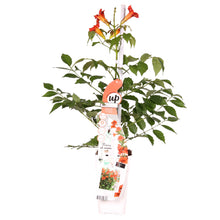Campsis radicans 'Flamenco', also known as the trumpet vine or trumpet creeper, is a vigorous and flamboyant deciduous climber prized for its profusion of large, trumpet-shaped flowers. This cultivar of Campsis radicans produces masses of showy, orange-red flowers with a vibrant yellow throat throughout the summer months. The flowers are a magnet for pollinators, especially hummingbirds and butterflies. It's a popular choice for covering walls, fences, and arbors, creating a dramatic and colourful display. It belongs to the Bignoniaceae family.
Origin: Campsis radicans is native to the eastern United States. 'Flamenco' is a cultivar selected for its vibrant flower colour.
Light: Campsis radicans 'Flamenco' thrives in full sun. It prefers at least 6-8 hours of direct sunlight per day to encourage optimal flowering.
Water: Water regularly, especially during dry periods and the first year after planting. Trumpet vine prefers consistently moist soil, but avoid overwatering, which can lead to root rot.
Soil: Campsis radicans 'Flamenco' is adaptable to a range of soil types, but prefers well-drained, fertile soil.
Support: As a vigorous climber, Campsis radicans 'Flamenco' needs strong support to grow. Provide a sturdy trellis, fence, or wires for the vine to climb on. It also produces aerial rootlets that can cling to surfaces.
Pruning: Pruning can help control the size and shape of your trumpet vine. Prune in late winter or early spring, removing any dead or damaged growth and cutting back to shape.
Hardiness: Campsis radicans 'Flamenco' is hardy and can tolerate cold winters.
Uses: This trumpet vine is primarily grown as an ornamental climber for its showy flowers and ability to attract pollinators. It's a popular choice for adding a splash of vibrant colour to gardens and outdoor spaces.
Toxicity: While generally not considered highly toxic, Campsis radicans 'Flamenco' can cause mild to moderate toxicity in humans and pets. The sap can cause skin irritation, and ingesting any part of the plant can lead to gastrointestinal upset, including vomiting and diarrhea. It's best to handle this plant with care, wearing gloves when pruning, and to keep it away from children and pets who might be tempted to chew on it.



